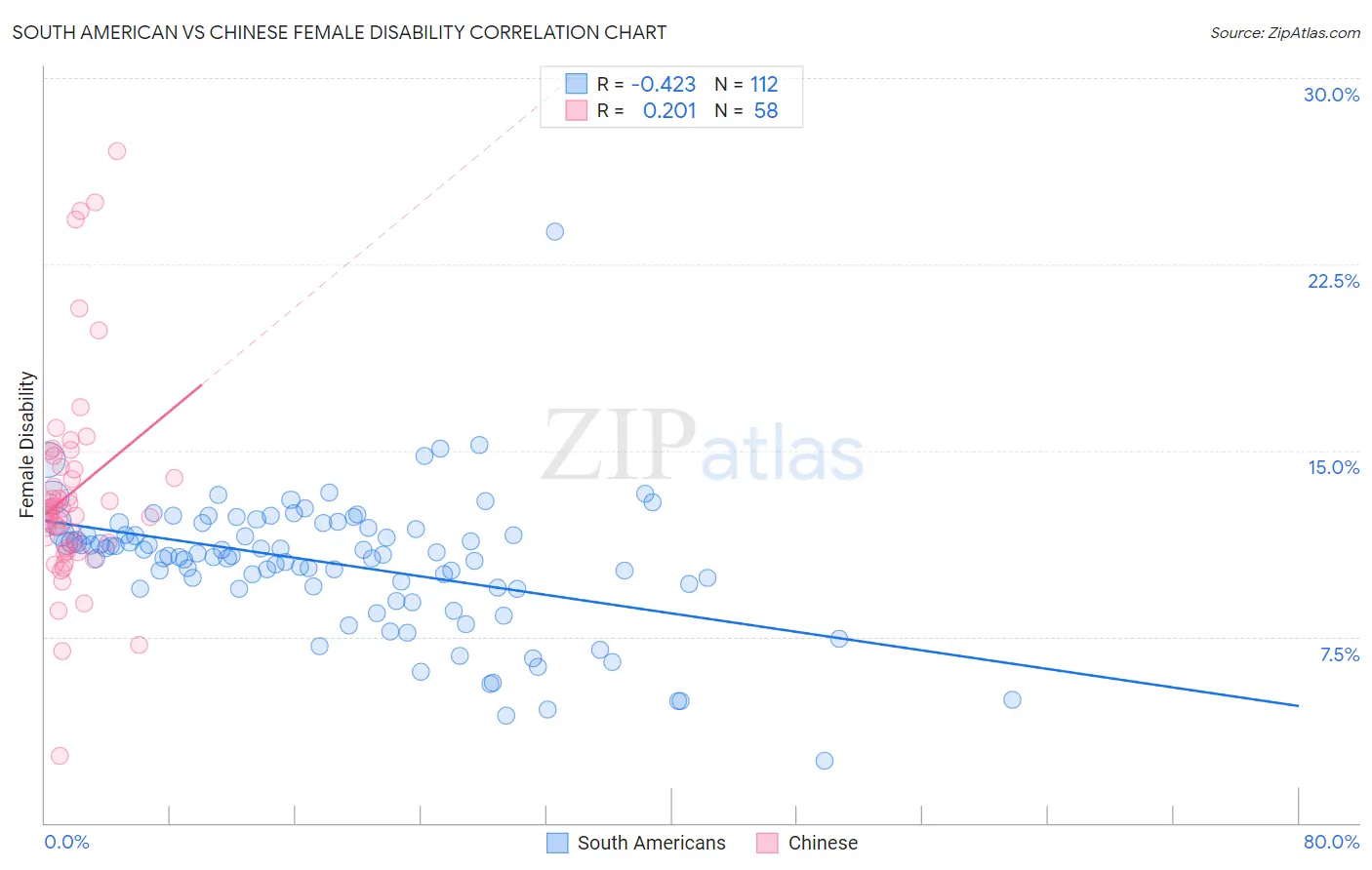South American vs Chinese Female Disability
COMPARE
South American
Chinese
Female Disability
Female Disability Comparison
South Americans
Chinese
11.4%
FEMALE DISABILITY
99.9/ 100
METRIC RATING
57th/ 347
METRIC RANK
12.3%
FEMALE DISABILITY
22.1/ 100
METRIC RATING
201st/ 347
METRIC RANK
South American vs Chinese Female Disability Correlation Chart
The statistical analysis conducted on geographies consisting of 494,047,696 people shows a moderate negative correlation between the proportion of South Americans and percentage of females with a disability in the United States with a correlation coefficient (R) of -0.423 and weighted average of 11.4%. Similarly, the statistical analysis conducted on geographies consisting of 64,802,500 people shows a weak positive correlation between the proportion of Chinese and percentage of females with a disability in the United States with a correlation coefficient (R) of 0.201 and weighted average of 12.3%, a difference of 8.5%.

Female Disability Correlation Summary
| Measurement | South American | Chinese |
| Minimum | 2.5% | 2.7% |
| Maximum | 23.8% | 27.1% |
| Range | 21.3% | 24.4% |
| Mean | 10.4% | 13.3% |
| Median | 10.8% | 12.6% |
| Interquartile 25% (IQ1) | 9.5% | 11.1% |
| Interquartile 75% (IQ3) | 11.9% | 14.3% |
| Interquartile Range (IQR) | 2.4% | 3.3% |
| Standard Deviation (Sample) | 2.7% | 4.3% |
| Standard Deviation (Population) | 2.7% | 4.3% |
Similar Demographics by Female Disability
Demographics Similar to South Americans by Female Disability
In terms of female disability, the demographic groups most similar to South Americans are Laotian (11.4%, a difference of 0.020%), Taiwanese (11.4%, a difference of 0.080%), Immigrants from Spain (11.4%, a difference of 0.15%), Immigrants from Bulgaria (11.4%, a difference of 0.27%), and Bulgarian (11.3%, a difference of 0.31%).
| Demographics | Rating | Rank | Female Disability |
| Inupiat | 100.0 /100 | #50 | Exceptional 11.3% |
| Immigrants | Belgium | 100.0 /100 | #51 | Exceptional 11.3% |
| Immigrants | Peru | 99.9 /100 | #52 | Exceptional 11.3% |
| Immigrants | Saudi Arabia | 99.9 /100 | #53 | Exceptional 11.3% |
| Peruvians | 99.9 /100 | #54 | Exceptional 11.3% |
| Bulgarians | 99.9 /100 | #55 | Exceptional 11.3% |
| Taiwanese | 99.9 /100 | #56 | Exceptional 11.4% |
| South Americans | 99.9 /100 | #57 | Exceptional 11.4% |
| Laotians | 99.9 /100 | #58 | Exceptional 11.4% |
| Immigrants | Spain | 99.9 /100 | #59 | Exceptional 11.4% |
| Immigrants | Bulgaria | 99.9 /100 | #60 | Exceptional 11.4% |
| Immigrants | France | 99.9 /100 | #61 | Exceptional 11.4% |
| Sri Lankans | 99.9 /100 | #62 | Exceptional 11.4% |
| Immigrants | Colombia | 99.9 /100 | #63 | Exceptional 11.4% |
| Immigrants | El Salvador | 99.9 /100 | #64 | Exceptional 11.4% |
Demographics Similar to Chinese by Female Disability
In terms of female disability, the demographic groups most similar to Chinese are Trinidadian and Tobagonian (12.3%, a difference of 0.010%), Somali (12.3%, a difference of 0.030%), Immigrants from Barbados (12.3%, a difference of 0.050%), Immigrants from Zaire (12.3%, a difference of 0.070%), and Immigrants from Grenada (12.4%, a difference of 0.090%).
| Demographics | Rating | Rank | Female Disability |
| Ukrainians | 27.2 /100 | #194 | Fair 12.3% |
| Swedes | 26.6 /100 | #195 | Fair 12.3% |
| Immigrants | Panama | 25.5 /100 | #196 | Fair 12.3% |
| Hondurans | 25.4 /100 | #197 | Fair 12.3% |
| Mexican American Indians | 24.9 /100 | #198 | Fair 12.3% |
| Immigrants | Trinidad and Tobago | 24.7 /100 | #199 | Fair 12.3% |
| Trinidadians and Tobagonians | 22.4 /100 | #200 | Fair 12.3% |
| Chinese | 22.1 /100 | #201 | Fair 12.3% |
| Somalis | 21.5 /100 | #202 | Fair 12.3% |
| Immigrants | Barbados | 21.1 /100 | #203 | Fair 12.3% |
| Immigrants | Zaire | 20.9 /100 | #204 | Fair 12.3% |
| Immigrants | Grenada | 20.5 /100 | #205 | Fair 12.4% |
| Immigrants | Cuba | 20.2 /100 | #206 | Fair 12.4% |
| Croatians | 20.2 /100 | #207 | Fair 12.4% |
| Basques | 17.5 /100 | #208 | Poor 12.4% |